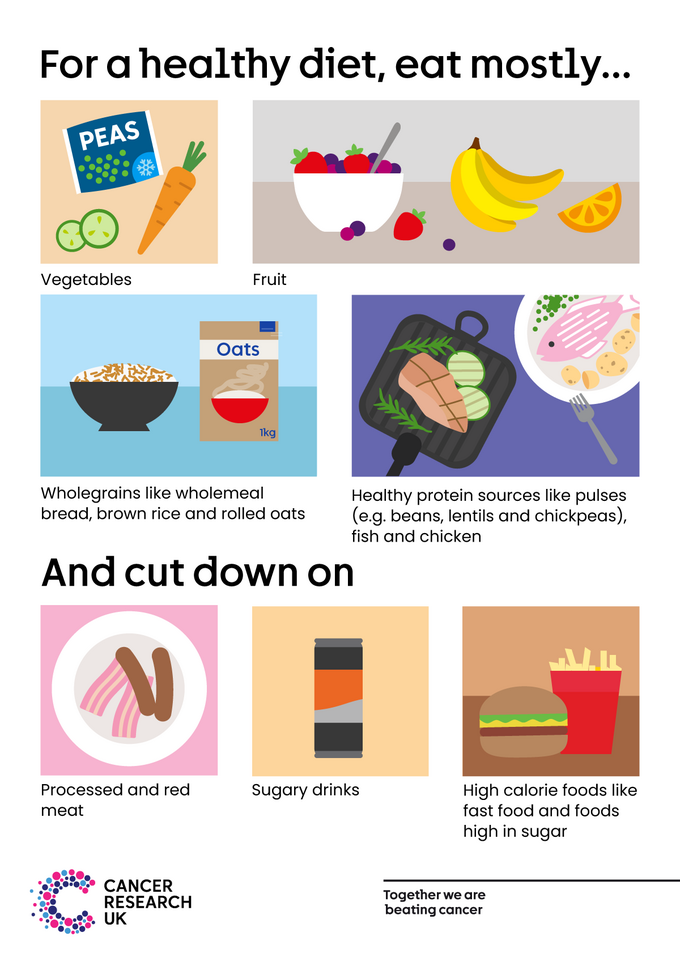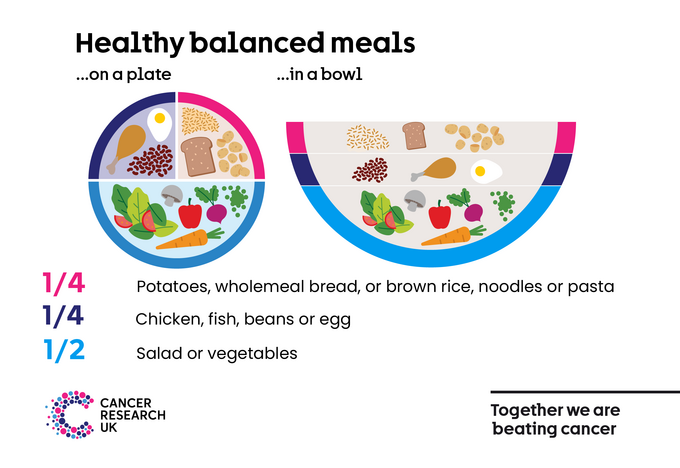How can I eat a healthy diet?
-
Your diet is what you usually eat and drink
-
Eat lots of fruit and vegetables, wholegrains, and healthy sources of protein like chicken, fish and pulses. Cut down on processed and red meat, alcohol, and foods that are high in fat, sugar and salt.
-
Follow our tips on how to cook healthy meals and how to shop for a healthy diet on a budget.
On this page you’ll find out what a healthy balanced diet is and get tips on how to make your diet healthier.
We have separate information on diet for people with cancer.
What is a healthy diet?
Your diet is what you eat and drink day-to-day. It’s the foods and drinks you usually have, or that you have the most in the week.
Eating a healthy balanced diet is important for getting the energy and nutrients we need for our mind and body to work. A healthy, balanced diet can also reduce the risk of cancer.
A healthy diet means eating mostly:
- fruits and vegetables,
- wholegrains, like wholewheat pasta, oats and wholemeal bread
- healthy sources of protein such as fish, pulses or chicken.
And cutting down on:
- processed and red meat,
- alcohol,
- and foods that are high in fat, sugar and salt.
We also have diagrams for what a vegan healthy balanced diet looks like, and African, Caribbean and South Asian cuisines.
Dairy can be part of a healthy, balanced diet
Dairy products like milk, cheese and yoghurt are a good source of protein and calcium. Eating and drinking dairy can lower your risk of bowel cancer. But some dairy products can be high in fat or sugar. So, try to choose lower sugar and lower fat options where possible.
Our page on milk, dairy and cancer risk has more advice on eating dairy and dairy alternatives as part of a healthy balanced diet.
Everyday and occasional foods
A healthy diet isn’t about following rules or the latest food trends. It’s about getting a good balance of foods and nutrients. One way to think about it is with ‘everyday foods’ and ‘occasional foods’.
Everyday foods are foods that we can and should eat regularly. Things like fruits, vegetables, oats, wholegrain versions of bread, pasta and rice and healthy sources of protein like fish, chicken, beans, lentils and chickpeas. They are usually lower in fat, salt and sugar than occasional foods.
Occasional foods are things that we can enjoy now and then, rather than eat every day. These foods are things like fast food, crisps, and sugary foods and drinks such as cake, chocolate, biscuits and fizzy drinks. They are often high in fat, salt or sugar.
Occasional foods shouldn’t make up a big part of your diet, so try to cut down if you are eating these foods often.
Do I need to cut down on sugar?
You don’t need to completely cut sugar out of your diet, and it wouldn’t be possible anyway! But generally, we should not eat more than 7 teaspoons of free sugars a day. This is sugars added to food and drink, or sugars from honey, syrups and fruit juices.
You may be surprised by how much sugar is in some of your food and drinks:
- One bowl of cereal can have around 5 teaspoons of sugar
- Half a jar of shop-bought pasta sauce can have up to 4 teaspoons of sugar
- One fruit yoghurt can contain around 3.5 teaspoons of sugar
- One small bottle of orange juice can have the full 7 teaspoons of sugar
Having too much sugar in your diet can make it harder to keep a healthy weight. And overweight and obesity increases the risk of cancer.
You don’t need to remember how much sugar is in different foods. Instead, look for traffic light labels on the packets. Try to choose foods that are green for sugar.
How to plan a healthy meal
Each healthy meal you eat builds up to form a healthy balanced diet across the week.
Think about how much space each food takes up on your plate or in your bowl.
1) Start with lots of fruits or vegetables
Fruits and vegetables should make up a big part of what you eat every day. When planning your meal, start with the vegetables or salad you want to have. Aim for this to fill at least half of your plate or bowl.
2) Add foods that are high in fibre, like wholegrains
Foods like potatoes, rice, bread and pasta should only make up a quarter of the meal. Try to choose wholegrains, such as the brown versions of pasta or rice, wild rice or wholemeal bread.
3) Add a healthy source of protein
Finally, add some protein to your meal. This could be chicken, turkey, fish, or pulses like lentils, chickpeas or beans. Aim to make this about a quarter of your plate or bowl.
Processed and red meat are linked to an increased risk of bowel cancer, so try to choose these less often in your meals.
Use our top tips to help you cut down on processed and red meat.
Think about your portions
Knowing how much food to cook or eat is important for getting the balance right. The recommended portion size depends on the food.
The British Nutrition Foundation have put together a guide to help you work out portion sizes.
Check food labels
Most packaged foods have traffic light labels to help you compare how much fat, sugar and salt is in a product. Look at the red (high), amber (medium) and green (low) colours on the label. Try to pick options that have more green and amber, and less red. If you’re out and about, quickly use the traffic light colours to choose healthier food on the go.
How to shop for a healthy diet on a budget
The world around us can make it hard to be healthy, and that includes shopping for healthy food.
Healthy foods can be more expensive than some of the less healthy options. It can also be difficult to find shops that sell healthier foods.
But we have some tips which can help you to shop for healthy food, even on a budget:
-
Plan your meals and make a shopping list. Decide what you want to eat for the week before doing your grocery shop. A meal plan will help you to buy only what you need for those meals and avoid unnecessary purchases and impulse buys.
-
Find the best value products. Don’t just look at the price of an item. Many shops also list the cost per 100g or 100ml on shelf labels. The lower the cost per 100g/ml the better value it is.
-
Check for items in the reduced section. If foods are getting close to their ‘sell by’ date, supermarkets and other shops may sell them at a discounted price. These foods can often include fruit, vegetables, chicken and fish. They are usually still good quality, just double check how they look and smell before buying them.
-
Don’t go shopping when you’re hungry. It can be tempting to put extra snacks in your basket or buy on-the-go foods when you’re hungry. These can be expensive. If you can, do your shop after a meal or have a healthy snack (such as fruit or plain nuts) with you.
How to cook quick healthy meals
Cooking healthy meals from scratch can feel difficult or time consuming. But there are ways to help it be done quickly and easily. And home cooking will help you save money instead of buying ready-made meals.
Try these healthy meal tips when cooking at home:
- Bulk out meals with vegetables and salad. Not only are veggies good for you, this will also save you money as they are generally cheaper than meats. Salads can often be made quickly without the need to cook.
- Avoid frying. Choose recipes that go in the oven rather than frying.
- Use healthier substitutes. Plain natural yogurt or creme fraiche can be used instead of cream in sauces for curries and pasta bakes.
- Batch cooking. Cook more than you need and freeze the leftovers into portions, ready to eat another day. It’s often cheaper to cook in bigger batches, too.
- Leave fruit and vegetable skins on. This avoids a time-consuming step of peeling! Not only that, the skins contain a lot of fibre and add extra flavour.
If you’re not sure where to start, here are some cupboard and essential items that can be used in lots of healthy meals:
- Tinned vegetables such as peas or sweetcorn
- Frozen vegetables such as green beans, carrots and spinach
- Tinned chopped tomatoes
- Tinned beans, tinned chickpeas and tinned lentils
- Tinned fish such as tuna or sardines
- Potatoes, garlic and onion
- Brown and wild rice
- Wholewheat noodles or pasta
- Dried grains such as couscous, bulgar and quinoa
There are lots of affordable, healthy meal ideas with step-by-step instructions on the NHS Healthier Families website.
Office for Health Improvement and Disparities. The Eatwell Guide. 2016. Available from: https://www.gov.uk/government/publications/the-eatwell-guide [Accessed April 2025]
British Nutrition Foundation. 2023. A healthy balanced diet. Available from: https://www.nutrition.org.uk/creating-a-healthy-diet/a-healthy-balanced-diet [Accessed April 2025]
British Dietetics Association. 2021. Eat Well, Spend Less. Available from: https://www.bda.uk.com/resource/food-facts-eat-well-spend-less.html [Accessed April 2025]
Ubago-Guisado E, Rodriguez-Barranco M, Ching-Lopez A, Petrova D, Molina-Montes E, Amiano P, et al. Evidence Update on the Relationship between Diet and the Most Common Cancers from the European Prospective Investigation into Cancer and Nutrition (EPIC) Study: A Systematic Review. Nutrients. 2021;13(10).
Last reviewed: 25 April 2025
Next due for review: 25 April 2028




